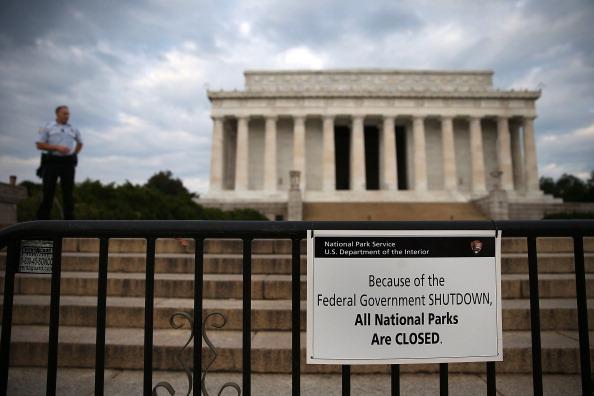|
|
|
|
|
|
Presidential Administration and Congressional Party Control |
|
1976 |
Thursday 09-30-76 |
10 |
Monday 10-11-76 |
Ford (R); Senate (D), House (D) |
|
1977 |
Friday 09-30-77 |
12 |
Thursday 10-13-17 |
Carter (D); Senate (D), House (D) |
|
1977 |
Monday 10-31-77 |
8 |
Wednesday 11-09-77 |
Carter (D); Senate (D), House (D) |
|
1977 |
Wednesday 11-30-77 |
8 |
Friday 12-09-77 |
Carter (D); Senate (D), House (D) |
|
1978 |
Saturday 09-30-78 |
17 |
Wednesday 10-18-78 |
Carter (D); Senate (D), House (D) |
|
1979 |
Sunday 09-30-79 |
11 |
Friday 10-12-79 |
Carter (D); Senate (D), House (D) |
|
1981 |
Friday 11-20-81 |
2 |
Monday 11-23-81 |
Reagan (R); Senate (R), House (D) |
|
1982 |
Thursday 9-30-82 |
1 |
Saturday 10-2-82 |
Reagan (R); Senate (R), House (D) |
|
1982 |
Friday 12-17-82 |
3 |
Tuesday 12-21-82 |
Reagan (R); Senate (R), House (D) |
|
1983 |
Thursday 11-10-83 |
3 |
Monday 11-14-83 |
Reagan (R); Senate (R), House (D) |
|
1984 |
Sunday 9-30-84 |
2 |
Wednesday 10-3-84 |
Reagan (R); Senate (R), House (D) |
|
1984 |
Wednesday 10-3-84 |
1 |
Friday 10-5-84 |
Reagan (R); Senate (R), House (D) |
|
1986 |
Thursday 10-16-86 |
1 |
Saturday 10-18-86 |
Reagan (R); Senate (R), House (D) |
|
1987 |
Friday 12-18-87 |
1 |
Sunday 12-20-87 |
Reagan (R); Senate (D), House (D) |
|
1990 |
Friday 10-5-90 |
3 |
Tuesday 10-9-90 |
George H.W. Bush (R); Senate (D), House (D) |
|
1995 |
Monday 11-13-95 |
5 |
Sunday 11-19-95 |
Clinton (D); Senate (R), House (R) |
|
1995-1996 |
Friday December 15, 195 |
21 |
Saturday 1-6-96 |
Clinton (D); Senate (R), House (R) |
|
2013 |
Tuesday, October 1, 2013 |
16 |
October 16, 2013 |
Obama (D); Senate (D), House (R) |
|
2018 |
Saturday, January 20, 2018 |
3 |
January 22, 2018 |
Trump (R); Senate (R), House (R) |
|
2018 |
Friday, February 9, 2018 |
1 (actually only nine hours) |
February 9, 2018 |
Trump (R); Senate (R), House (R) |
|
2018-2019 |
Saturday, December 22, 2018 |
35 |
January 25, 2019 |
Trump (R); Senate (R), House (R)/House (D) -When this shutdown began, the Republicans controlled the House, but in early January, due to the November, 2018 elections, the Democrats became the majority party in the Senate. |
However, by 2013, the ongoing budget and philosophical differences over Obamacare, resulted in an impasse between the Tea Party faction of the Republian-controlled House and the Obama White House. As a result, the first Federal government shutdown of the 21st Century began on October 1, 2013. Congress and President Obama took 16 days to resolve their differences and end the shutdown.
In January, 2018 in the first serious government shutdown threat of the Trump admistration arose, with various factions within the Republican Party, along with the minority Democrats, arguing over the budget, threatening a new shutdown. Roadblocks to a settlement included funding for President Trump's border wall, and the insistence by Democrats that protections for undocumented immigrants referred to as "Dreamers," be included in any bill. The House passed a three-week spending bill late on Friday, January 19, but the Senate did not follow suit, leading to a shutdown of the federal government at midnight. Ironically, the date the shutdown began, January 20, is the one-year anniversary of President Trump's inauguration.
The second "shutdown" of the Trump era came on February 9, 2018, with a funding gap. This gap in federal appropriations only lasted for nine hours, and occurred overnight, it is referred to as a federal government shutdown.
The third shutdown in 2018 began on Decemer 22, 2018, with a political deadlock over the budget, as President Trump and his supporters refused a deal that did not include nearly $5 billion for his proposed Mexican border wall. President Trump's chances for the House to appropriate any monies for the wall, which was a campaign promise of his, declines drastically after the new year, when a Democratic majority takes over the House. This partial shutdown turned into the longest Federal Government shutdown in history, as it extended into 2019. The leading Democratic leader, Nancy Pelosi, regained the Speakership of the House and engaged in verbal battles with President Trump over the shutdown. On January 25, 2019, President Trump announced a temporary spending plan to halt the shutdown, but with an expiration date of February 15. He did not get the money for the border wall, but indicated negotiations on that would continue. This federal government shutdown was the longest in history, going for 35 days. The severity of this shutdown for federal workers was to the point that state and local governments were stepping in to provide aid and federal workers were going to food banks in order to feed their families. One example of state aid was in Washington State, where Governor Jay Inslee, who at that time was considering entering the presidential race for 2020, extended state unemployment assistance to the tens of thousands of furloughed and unpaid federal workers in his state.
President Trump announces deal with Democrats to end 2018-2019 shutdown
Source: The Congressional Research Service Report 98-844: Shutdown of the Federal Government:
Causes, Effects, and Process
Copyright © 1998-2019 History Guy Media; Last Modified: 01.25.19
"The History Guy" is a Registered Trademark
